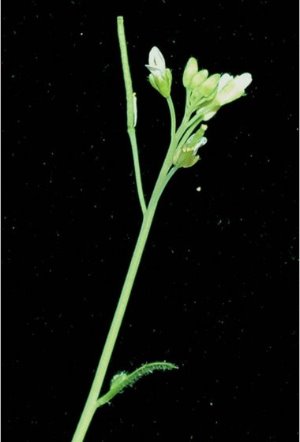Dec. 5, 2008 Research Highlight Biology
Making sense of the antisense
Additions to the genome map yield important clues on how plants respond and adapt to adverse environmental conditions
 Figure 1: Many previously unidentified genes, transcribed under conditions of environmental stress, are now known for the model plant Arabidopisis thaliana.
Figure 1: Many previously unidentified genes, transcribed under conditions of environmental stress, are now known for the model plant Arabidopisis thaliana.
A team of plant biologists in Japan has mapped uncharted areas of the plant genome by describing the full set of RNA molecules transcribed from genes activated under environmental stress. Importantly, as part of this compendium known as the transcriptome, the researchers have identified many non-protein-coding RNAs. Although abundant in living organisms, the function of non-coding RNAs remains a mystery, but the team has provided evidence that they play regulatory roles in gene regulation under the stress.
Led by Motoaki Seki of the RIKEN Plant Science Center in Yokohama, the researchers have described the transcriptome of the model plant Arabidopsis thaliana (Fig. 1) under conditions of drought, high salinity and cold by using the tiling array technique—a popular tool employed to identify all the genes that are activated and transcribed into RNAs under particular conditions—on a whole-genome scale.
The researchers found nearly 8,000 previously unidentified transcribed regions, including many that are induced or suppressed in response to stress. And, about 80% of the RNAs that they identified belonged to so-called sense/antisense pairs. Protein coding RNAs are transcribed from DNA in the ‘sense’ direction and their complementary molecules are transcribed in the opposite, or ‘antisense’, direction. Sense/antisense pairs can be transcribed in opposite directions from the same genetic locus.
As published recently in Plant and Cell Physiology 1, Seki and his colleagues have found a linear correlation between the expression of sense transcripts and antisense transcripts in plants under environmental stress. The importance of sense/antisense pairs lies in the potential for antisense RNA to regulate translation of sense RNAs into proteins by various mechanisms. The researchers therefore believe that antisense RNAs may help plants to adapt under various stresses by regulating the translation of sense RNA into proteins. Interestingly, they found that the transcription of sense RNA is necessary for the expression of the antisense RNA and thus conclude that sense and antisense RNA co-regulate the stress response.
Improving the stress tolerance of crops by gene manipulation is a goal that requires plant biologists to have an intimate knowledge of the molecular mechanisms behind plant reactions to environmental challenges. The findings that non-coding antisense RNA plays a role in gene expression under environmental stress and sense/antisense pairs may co-regulate stress responses greatly adds to this body of knowledge. The latter finding also expands our understanding of coordinate gene regulation in higher eukaryotes, notes Seki.
References
- 1. Matsui, A., Ishida, J., Morosawa, T., Mochizuki, Y., Kaminuma, E., Endo, T.A., Okamoto, M., Nambara, E., Nakajima, M., Kawashima, M. et al. Arabidopsis transcriptome analysis under drought, cold, high-salinity and ABA treatment conditions using a tiling array. Plant and Cell Physiology 49, 1135–1149 (2008). doi: 10.1093/pcp/pcn101
